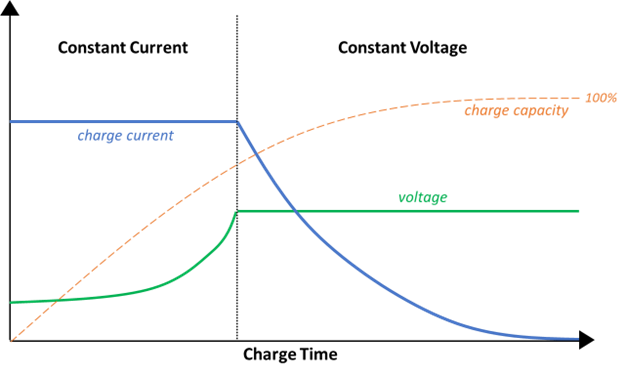Rechargeable batteries are used in almost every aspect of our everyday lives. Smartphones and laptops use small lithium-ion (Li-ion) batteries. Vehicles rely on lead-acid batteries for their ignition systems. Hybrids and electric vehicles are now commonplace on the roads. Cities across the world rely on large-scale battery banks for backup power. Many countries have passed aggressive electrification legislation, which will lead to even more widespread use of batteries. Today’s post will explain the different types of charging methods, including when and why they are used.
Constant Current (CC) vs. Constant Voltage (CV)
CC charging simply means charging a battery at a constant current, typically used during initial charge steps until the battery reaches a certain set voltage. CV charging is a technique that charges a battery at a constant voltage, starting with a higher current that slowly decreases. Lithium-ion batteries generally use a 2-stage CC-CV charging process. In stage 1, the battery will charge at a constant current and the battery voltage will increase. Once it reaches a certain voltage, stage 2 begins, where the battery is kept at that voltage as the current gradually decays. Complex electronics located within your smartphone and devices regulate the voltage/current to prevent overcharging.

Pulse Charge
Pulse charging uses alternating on/off steps that can vary in width and current. This type of charging is intended to allow the chemical reactions taking place in the battery to stabilize during the rest periods. Side reactions, such as gas formation in nickel metal hydride (NiMH) batteries, can increase the pressure within battery cells. Pulse charging allows the gas sufficient time to dissipate during the rest period before the next charge pulse. This type of charging is also believed to be effective at breaking down crystalline solids that may form within the active material of some batteries.
Fast Charge
Smartphones, EV chargers, and other devices now advertise “fast charging” capabilities, but what does that mean? Your standard (USB-A) iPhone charger has 5W capability. Using a 20 W iPhone charger (USB-C), you can charge your phone up to 50% in 30 minutes.
To achieve fast charging, manufacturers must increase either the voltage or current capability. The 20 W iPhone charger pushes the voltage to 9V, 2.22A from the standard 5V, 1A. One important note is that this fast-charging rate can only be used when at a lower charge. You will also notice that the phone gets much hotter when charging at 20 W. Once the battery starts approaching full charge, the current will taper down. The table below shows the differences between standard iPhone charging and fast iPhone charging.

Trickle/Float Charge
Trickle and float charges are similar concepts but differ in their intended purpose. Trickle charging supplies batteries with a low constant current to counteract any self-discharge that occurs. This is mainly for keeping batteries on standby or storage, though the user must be careful to prevent overcharging. Float charging is a technique that keeps batteries at a constant voltage, close to full charge. This is used for backup power systems, where batteries would need to be fully charged in case of grid failures.
Many of our electronic devices use a combination of these techniques to effectively charge their batteries. Complex algorithms monitor battery voltage, count coulombs, and measure current responses to keep our device batteries healthy, charged, and ready to be used.
A3 Global
A3 Global makes electrochemical equipment for hybrid vehicle battery reconditioning, fuel cells, batteries, and electrosynthesis, including custom electronics and R&D. We repair, remanufacturer, repurpose and sell hybrid batteries to optimize and extend the life of your batteries, giving them a second life at a fraction of the cost of new. A3 is leading the world to advanced electrochemical technologies, electrochemical technology, and education. To learn more about NuVant Systems click here. To learn more about Hybrid Battery 911 click here.



